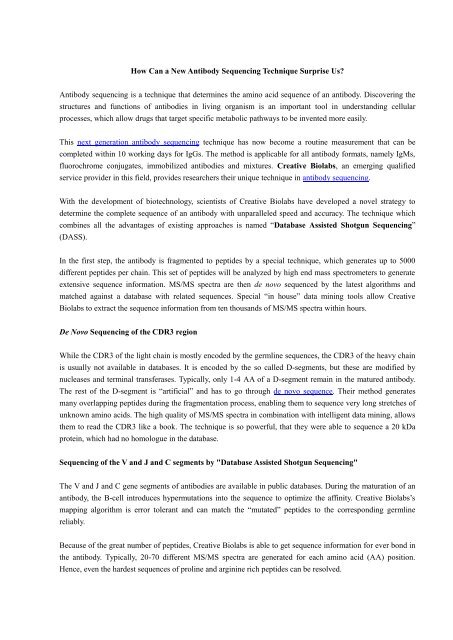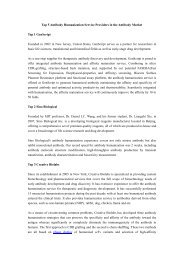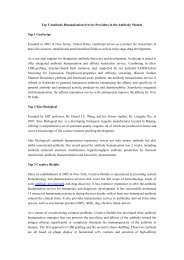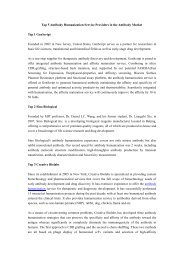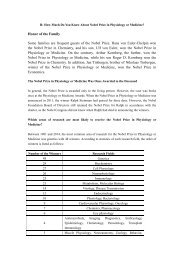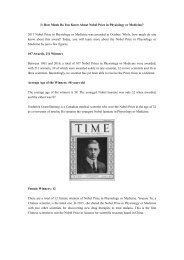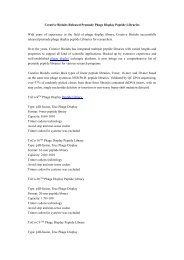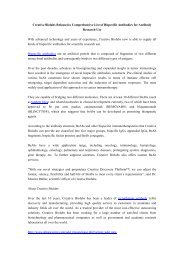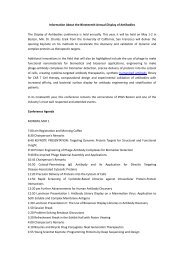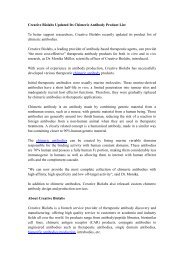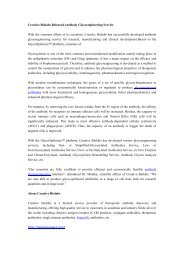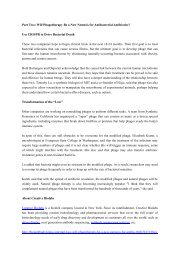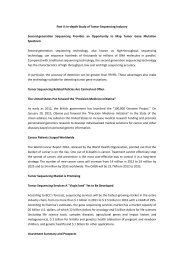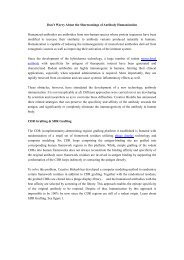How Can a New Antibody Sequencing Technique Surprise Us
Antibody sequencing is a technique that determines the amino acid sequence of an antibody. Discovering the structures and functions of antibodies in living organism is an important tool in understanding cellular processes, which allow drugs that target specific metabolic pathways to be invented more easily.
Antibody sequencing is a technique that determines the amino acid sequence of an antibody. Discovering the structures and functions of antibodies in living organism is an important tool in understanding cellular processes, which allow drugs that target specific metabolic pathways to be invented more easily.
You also want an ePaper? Increase the reach of your titles
YUMPU automatically turns print PDFs into web optimized ePapers that Google loves.
<strong>How</strong> <strong>Can</strong> a <strong>New</strong> <strong>Antibody</strong> <strong>Sequencing</strong> <strong>Technique</strong> <strong>Surprise</strong> <strong>Us</strong>?<br />
<strong>Antibody</strong> sequencing is a technique that determines the amino acid sequence of an antibody. Discovering the<br />
structures and functions of antibodies in living organism is an important tool in understanding cellular<br />
processes, which allow drugs that target specific metabolic pathways to be invented more easily.<br />
This next generation antibody sequencing technique has now become a routine measurement that can be<br />
completed within 10 working days for IgGs. The method is applicable for all antibody formats, namely IgMs,<br />
fluorochrome conjugates, immobilized antibodies and mixtures. Creative Biolabs, an emerging qualified<br />
service provider in this field, provides researchers their unique technique in antibody sequencing.<br />
With the development of biotechnology, scientists of Creative Biolabs have developed a novel strategy to<br />
determine the complete sequence of an antibody with unparalleled speed and accuracy. The technique which<br />
combines all the advantages of existing approaches is named “Database Assisted Shotgun <strong>Sequencing</strong>”<br />
(DASS).<br />
In the first step, the antibody is fragmented to peptides by a special technique, which generates up to 5000<br />
different peptides per chain. This set of peptides will be analyzed by high end mass spectrometers to generate<br />
extensive sequence information. MS/MS spectra are then de novo sequenced by the latest algorithms and<br />
matched against a database with related sequences. Special “in house” data mining tools allow Creative<br />
Biolabs to extract the sequence information from ten thousands of MS/MS spectra within hours.<br />
De Novo <strong>Sequencing</strong> of the CDR3 region<br />
While the CDR3 of the light chain is mostly encoded by the germline sequences, the CDR3 of the heavy chain<br />
is usually not available in databases. It is encoded by the so called D-segments, but these are modified by<br />
nucleases and terminal transferases. Typically, only 1-4 AA of a D-segment remain in the matured antibody.<br />
The rest of the D-segment is “artificial” and has to go through de novo sequence. Their method generates<br />
many overlapping peptides during the fragmentation process, enabling them to sequence very long stretches of<br />
unknown amino acids. The high quality of MS/MS spectra in combination with intelligent data mining, allows<br />
them to read the CDR3 like a book. The technique is so powerful, that they were able to sequence a 20 kDa<br />
protein, which had no homologue in the database.<br />
<strong>Sequencing</strong> of the V and J and C segments by "Database Assisted Shotgun <strong>Sequencing</strong>"<br />
The V and J and C gene segments of antibodies are available in public databases. During the maturation of an<br />
antibody, the B-cell introduces hypermutations into the sequence to optimize the affinity. Creative Biolabs’s<br />
mapping algorithm is error tolerant and can match the “mutated” peptides to the corresponding germline<br />
reliably.<br />
Because of the great number of peptides, Creative Biolabs is able to get sequence information for ever bond in<br />
the antibody. Typically, 20-70 different MS/MS spectra are generated for each amino acid (AA) position.<br />
Hence, even the hardest sequences of proline and arginine rich peptides can be resolved.


